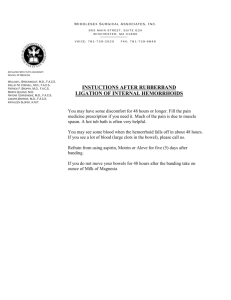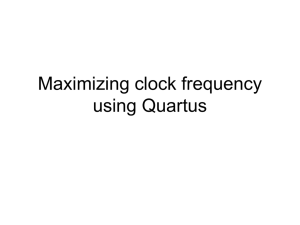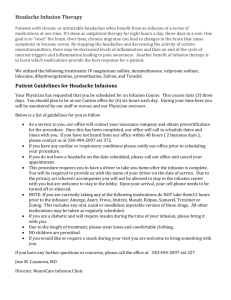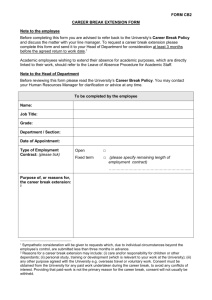SDC Page ONLINE METHODS Evaluation of Cardiac Function
advertisement
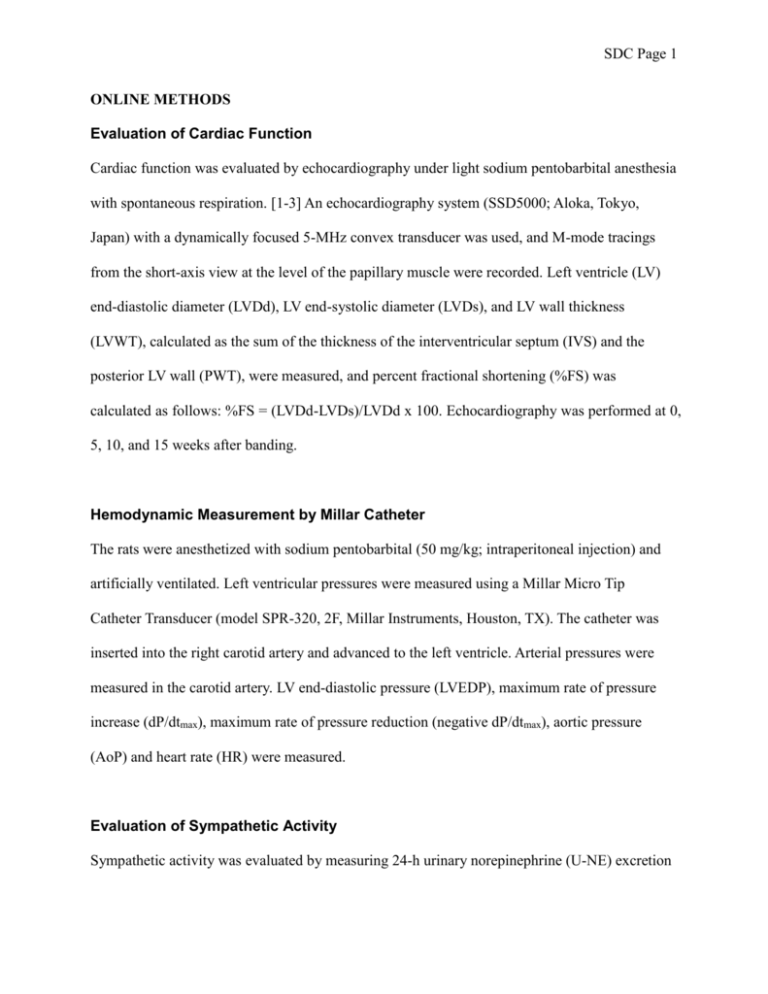
SDC Page 1 ONLINE METHODS Evaluation of Cardiac Function Cardiac function was evaluated by echocardiography under light sodium pentobarbital anesthesia with spontaneous respiration. [1-3] An echocardiography system (SSD5000; Aloka, Tokyo, Japan) with a dynamically focused 5-MHz convex transducer was used, and M-mode tracings from the short-axis view at the level of the papillary muscle were recorded. Left ventricle (LV) end-diastolic diameter (LVDd), LV end-systolic diameter (LVDs), and LV wall thickness (LVWT), calculated as the sum of the thickness of the interventricular septum (IVS) and the posterior LV wall (PWT), were measured, and percent fractional shortening (%FS) was calculated as follows: %FS = (LVDd-LVDs)/LVDd x 100. Echocardiography was performed at 0, 5, 10, and 15 weeks after banding. Hemodynamic Measurement by Millar Catheter The rats were anesthetized with sodium pentobarbital (50 mg/kg; intraperitoneal injection) and artificially ventilated. Left ventricular pressures were measured using a Millar Micro Tip Catheter Transducer (model SPR-320, 2F, Millar Instruments, Houston, TX). The catheter was inserted into the right carotid artery and advanced to the left ventricle. Arterial pressures were measured in the carotid artery. LV end-diastolic pressure (LVEDP), maximum rate of pressure increase (dP/dtmax), maximum rate of pressure reduction (negative dP/dtmax), aortic pressure (AoP) and heart rate (HR) were measured. Evaluation of Sympathetic Activity Sympathetic activity was evaluated by measuring 24-h urinary norepinephrine (U-NE) excretion SDC Page 2 using high-performance liquid chromatography, as previously described. [4, 5] NRG-1β treatment protocol The mini-osmotic pump, filled with vehicle or NRG-1β, was implanted subcutaneously in the back and connected to a polyethylene tube (PE10). A small hole was then made in the atlanto-occipital membrane that covers the dorsal surface of the medulla, and the tip of the tube was placed intracisternally and fixed in place with tissue adhesive. After full recovery from anesthesia, the rats were free to move about in their cages. Chronic intracisternal or intraperitoneal infusion of NGR-1β (Ray Biotech, Norcross, GA) was performed at 5 weeks after banding for 2 weeks using a subcutaneously or intraperitoneally implanted mini-osmotic pump (Alzet model 1002; Durect Corporation, Cupertino, CA). The surgical procedures were performed as described previously. [6] Infusion was stopped 14 days after initiation. Rats were divided into six groups as follows: (1) sham-operated rats (sham); (2) nontreated banding rats (AB); (3) low-dose (0.05 μg/kg/day) NRG-1β intracisternal infusion (IC low); (4) low-dose (0.05 μg/kg/day) NRG-1β intraperitoneal infusion (IP low); (5) high-dose (0.5μg/kg/day) NRG-1β intracisternal infusion (IC high); (6) high-dose (0.5μg/kg/day) NRG-1β intraperitoneal infusion (IP high). The doses were determined based on previous studies. [7, 8] Western Blot Analysis Rabbit immunoglobulin G (IgG) monoclonal antibodies against NRG-1 (1:1000), ErbB2, (1:1000), and ErbB4 (1:1000) were used as the primary antibodies. All antibodies were purchased from Santa Cruz Biochemical (Santa Cruz, CA). The animals were anesthetized using SDC Page 3 sodium pentobarbital (100 mg/kg; intraperitoneal injection) and perfused transcardially with phosphate-buffered saline (PBS). The brains and whole hearts were removed quickly. The tissues were homogenized and then sonicated in lysis buffer containing 40 mmol/L HEPES, 1% Triton X-100, 10% glycerol, 1 mmol/L phenylmethanesulfonyl fluoride, and 1 protease inhibitor cocktail tablet (Roche Diagnostics, Indianapolis, IN). The tissue lysate was centrifuged in a microcentrifuge at 6000 rpm for 5 min at 4°C. The lysate was collected, and the protein concentration determined using a bicinchoninic acid protein assay kit (Pierce Chemical, Rockford, IL). Aliquots of protein (10 μg) from each sample were separated on a 7.5% sodium dodecyl sulfate-polyacrylamide gel. Subsequently, separated proteins were transferred onto polyvinylidene difluoride membranes (Immobilon-P membrane; Millipore, Billerica, MA). The membranes were incubated with rabbit IgG monoclonal antibody for 24 to 48 h. The membranes were then washed and incubated with horseradish peroxidase-conjugated horse anti-rabbit IgG antibody (1:10,000) for 40 min. Immunoreactivity was detected using autoradiography with enhanced chemiluminescence and a Western blotting detection kit (GE Healthcare, Tokyo, Japan). ELISA A mini-osmotic pump, filled with vehicle or NRG-1β, was implanted intraperitoneally. Rats were divided into three groups (n=3 for each), including control (vehicle), IP-low (NRG-1β: 0.05 μg/kg/day), and IP-high (NRG-1β: 0.5 μg/kg/day). Serum samples were collected by drawing blood from the carotid artery 2 weeks after the initiation of treatment. We used an enzyme-linked immunosorbent assay (ELISA) kit (TSZ Scientific LLC, Framingham, MA) specific for feline NRG1 to quantify NRG1 protein according to the manufacturer's protocol. Briefly, protein SDC Page 4 samples from rat serum were diluted and added to a 96-well plate precoated with the primary antibody to NRG1; the plate was then covered tightly and incubated for 30 min at room temperature. After washing, horseradish peroxidase conjugate was added to each well in duplicate. The plate was incubated for 30 min, washed, and chromogen substrates A and B were added to each well. After 30 min incubation, the reaction was stopped with the stop solution and the plate was analyzed in an Emax microplate reader (Molecular Devices) at 450 and 570 nm within 15 min. The NRG-1β concentration was expressed in picograms of NRG-1β per milliliter of total serum. Statistical Analysis All values are expressed as the mean ± SEM. Changes in the %FS, LVDd, LVDs, and LVWT values by echocardiography were compared using a two-way analysis of variance (ANOVA). Expression levels of NRG-1, ErbB2, and ErbB4 in the heart were compared using a paired t-test. The other values were compared using a one-way ANOVA. In the ANOVA, comparisons between any two mean values were performed using Bonferroni’s correction for multiple comparisons. Differences were considered significant when the P value was less than 0.05. Study limitations This study has some technical limitations. First, rhNRG-1β was administered by intracisternal infusion. We previously reported that rhNRG-1β signaling is important in the RVLM. We cannot, however, exclude possible effects of rhNRG-1β at other brain sites. It is technically difficult to chronically administer drugs into the RVLM. In this regard, further studies are necessary to determine the role of NRG-1/ErbB signaling in other nuclei on HF. Second, we demonstrated SDC Page 5 reduction in urinary norepinephrine excretion as sympathetic nerve activity. This method, however, cannot distinguish between cardiac sympathetic nerve activity and renal sympathetic nerve activity. For this purpose, it would be preferable to measure cardiac and renal norepinephrine spillover. We believe that NRG-1 affects systemic sympathetic nerve activity due to its central effect. At this time, however, we cannot determine whether mainly cardiac or renal sympathetic nerve activity is affected. SDC Page 6 REFERECES 1. Ito K, Hirooka Y, Sunagawa K. Acquisition of brain Na sensitivity contributes to salt-induced sympathoexcitation and cardiac dysfunction in mice with pressure overload. Circ Res. 2009;104:1004-1011. 2. Ito K, Hirooka Y, Sunagawa K. Blockade of mineralocorticoid receptors improves salt-induced left-ventricular systolic dysfunction through attenuation of enhanced sympathetic drive in mice with pressure overload. J Hypertens. 2010;28:1449-1458. 3. Ito K, Hirooka Y, Matsukawa R, Nakano M, Sunagawa K. Decreased brain sigma-1 receptor contributes to the relationship between heart failure and depression. Cardiovasc Res. 2012;93:33-40. 4. Kishi T, Hirooka Y, Sakai K, Shigematsu H, Shimokawa H, Takeshita A. Overexpression of eNOS in the RVLM causes hypotension and bradycardia via GABA release. Hypertension. 2001;38:896-901. 5. Sakai K, Hirooka Y, Matsuo I, Eshima K, Shigematsu H, Shimokawa H, Takeshita A. Overexpression of eNOS in NTS causes hypotension and bradycardia in vivo. Hypertension. 2000;36:1023-1028. 6. Kimura Y, Hirooka Y, Sagara Y, Ito K, Kishi T, Shimokawa H, Takeshita A, Sunagawa K. Overexpression of inducible nitric oxide synthase in rostral ventrolateral medulla causes hypertension and sympathoexcitation via an increase in oxidative stress. Circ Res. 2005;96:252-260. 7. Liu X, Gu X, Li Z, Li X, Li H, Chang J, Chen P, Jin J, Xi B, Chen D, Lai D, Graham RM, Zhou M. Neuregulin-1/erbB-activation improves cardiac function and survival in models of ischemic, dilated, and viral cardiomyopathy. J Am Coll Cardiol. 2006;48:1438-1447. SDC Page 7 8. Matsukawa R, Hirooka Y, Nishihara M, Ito K, Sunagawa K. Neuregulin-1/ErbB signaling in rostral ventrolateral medulla is involved in blood pressure regulation as an antihypertensive system. J Hypertens. 2011;29:1735-1742. SDC Page 8 ONLINE FIGURE LEGENDS ONLINE FIGUARE 1 Western blot of (A) NRG-1, (B) ErbB2, and (C) ErbB4 in the brainstem of sham rats. Western blot was performed at 0 (before sham operation), 5, 10, and 15 weeks (W) after sham operation. The densitometric average was normalized to the values obtained from the analysis of β-tubulin as an internal control. Expression is shown relative to that at 0 W, which was assigned a value of 1. Values are expressed as mean ± SEM (n=5-6 for each). ONLINE FIGURE 2 Effects of aortic banding and low dose of rhNRG-1βon the heart. A, Example of the heart at 15 weeks after banding. B, Representative M-mode echocardiography at 15 weeks after banding. ONLINE FIGURE 3 Expression of NRG-1 (A), ErbB2 (B), and ErbB4 (C) in the heart at 15 weeks (W) after banding. The densitometric average was normalized to the values obtained from the analysis of β-tubulin as an internal control. Expression is shown relative to that in sham, which was assigned a value of 1. Values are expressed as mean ± SEM. *, P < 0.05 (vs. sham; n=6 for each)
